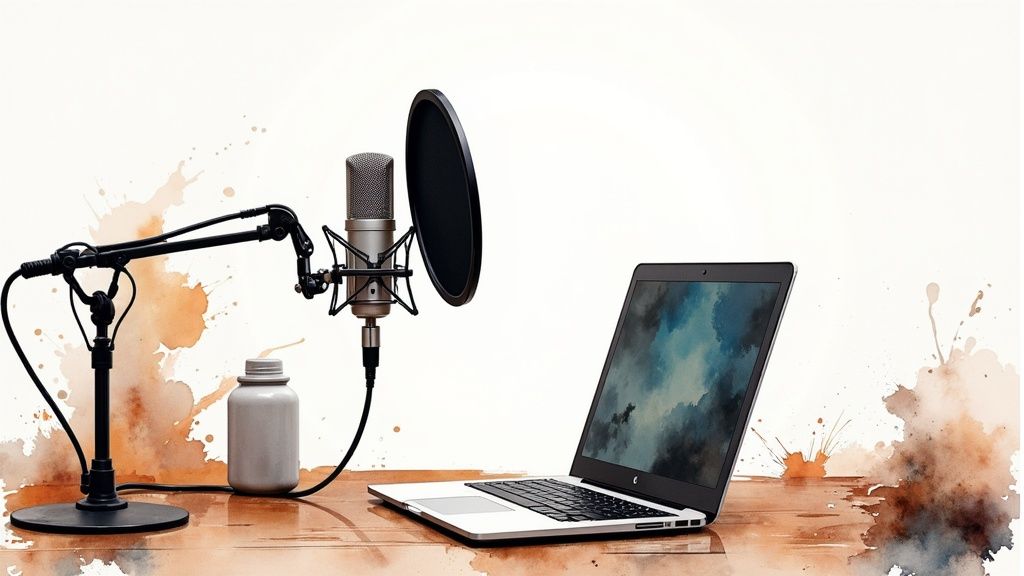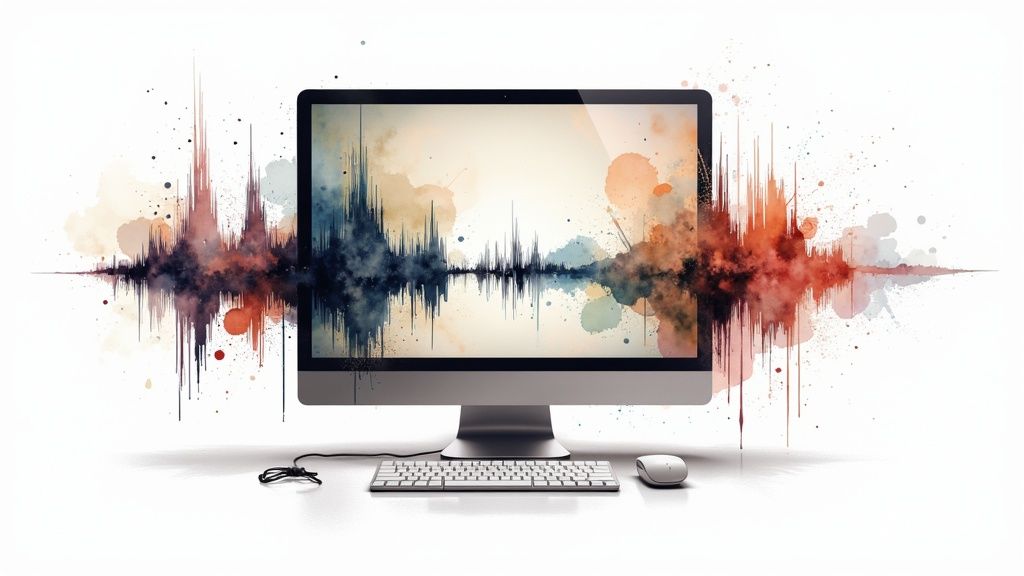Introduction to Video Voice Overs: A Comprehensive Guide

In the world of online video, visuals are only part of the equation. A compelling voice over truly brings content to life, adding depth, emotion, and clarity. Think of it as the narrator in a film, guiding the viewer, providing context, and shaping the overall experience. This vital role makes understanding voice over creation essential for engaging and professional video content. Whether you're creating explainer videos, social media clips, or documentaries, a quality voice over significantly elevates their impact. This guide explores what constitutes a voice over and its importance in maximizing video effectiveness.
What exactly is a video voice over? It's simply recorded narration added to a video, often without the speaker appearing on screen. It's the unseen storyteller, weaving the narrative together. For instance, in a product demo, the voice over might describe features while visuals showcase the product in action. Voice overs also create different moods. A calming voice builds trust in educational videos, while an energetic voice excites viewers in promotional content. This versatility makes voice overs an invaluable tool for video creators.
Why are video voice overs so important? They enhance accessibility, engagement, and effectiveness. They simplify complex information, especially when paired with reinforcing visuals, which is particularly helpful in educational videos. A well-crafted voice over also adds personality and emotion, making content more memorable and shareable. Imagine a travel vlog without narration: the personal stories and insights that bring the journey to life would be lost. Essentially, a voice over bridges your visuals with the viewer's understanding and emotions, boosting engagement and overall impact. Learning how to create effective voice overs is key to enhancing your video content.
Essential Equipment for Voice Overs
Understanding the importance of quality voice overs leads us to the essential equipment. Just as an artist needs the right tools, creating professional voice overs requires specific hardware and software. Investing in these tools improves both the process and the final product.

Capturing clear audio is paramount, making certain hardware essential. A good microphone accurately captures vocal nuances, minimizing noise and distortion. While studio microphones are ideal, USB microphones offer a good balance for beginners. Condenser microphones, for example, are popular for voice work due to their sensitivity and clarity. Closed-back headphones are crucial for real-time monitoring, preventing sound leakage and allowing you to hear exactly what's being recorded. This helps maintain a clean audio track. Pop filters are inexpensive tools that reduce plosive sounds from "p" and "b" consonants. An audio interface, though optional for beginners, enhances audio quality and lowers latency, providing more control.
With your hardware in place, recording and editing software is the next step. Options range from free to professional-grade programs. Audacity, a powerful open-source editor, is ideal for beginners due to its range of tools and ease of use. GarageBand, free for Mac users, provides a user-friendly interface with a solid selection of recording and editing features. Adobe Audition, a paid option, offers advanced tools for cleaning, adding effects, and mastering recordings. Choosing software depends on your budget and experience. Starting with free software is a practical way to learn before investing. Regardless of choice, mastering the software, including adjusting levels, removing noise, and adding effects, is crucial. This lays the foundation for creating a compelling script, the next step in our journey.
Crafting Your Voice Over Script
Having covered software and hardware, let’s focus on the heart of your voice over: the script. Just as a good story requires structure, your voice over needs a strong script to convey your message. This transforms your ideas into words that resonate with your audience. Writing a captivating script is as important as having excellent equipment; it's the blueprint for success.
Before writing, define your audience and video purpose. Who are you addressing and what message should they retain? If your video targets teenagers, the language will differ from one aimed at business professionals. A product demo script focuses on features and benefits, while a documentary emphasizes storytelling. Understanding your audience and purpose is crucial.
Next, structure your script like a mini-movie, with a beginning, middle, and end. Start with a hook—a question, statistic, or anecdote—to grab attention. The middle develops your core message with supporting details. For example, when explaining how to create a voice over, break down the steps clearly. End with a call to action, prompting viewers to visit your website, subscribe, or share. This structure maintains engagement.
Even with good structure, a script must sound natural. Aim for a conversational tone, like speaking to a friend. Avoid jargon and complex sentences. Short sentences are effective. Read aloud as you write to catch awkward phrasing. Your script should inform and connect, making information accessible and memorable. This conversational approach makes your script relatable. With a strong script, you're ready to record.
Effective Recording Techniques
With your script finalized and equipment ready, it's time to record. This is where preparation translates into a tangible product. Think of it as a musician entering the recording booth after rehearsals – excitement is high, and the potential is immense. Mastering recording techniques is key to capturing a professional voice over that elevates your script.

Setting the right environment is crucial. Minimize background noise and optimize microphone placement. Recording in a closet filled with clothes can absorb echoes, creating a controlled acoustic space. Microphone position is also key; experiment to find the sweet spot that captures your voice clearly.
Mastering microphone technique is essential. Speaking directly into the microphone can create harsh sounds, so positioning it slightly off-center often produces a warmer sound. Maintain consistent distance to avoid volume fluctuations. This consistency ensures a balanced and professional sound.
Now, bring your script to life. Reading aloud beforehand ensures a natural delivery and helps identify any tongue-twisters. Injecting emotion and personality captivates listeners. Think of yourself as a storyteller, using vocal inflection and tone to engage your audience. Embody the script's message, conveying appropriate emotion. This elevates your voice over from narration to performance.
Throughout recording, monitor your audio for background noise and maintain consistent vocal levels. Address any issues immediately. This active listening and adjustment process saves time during editing and ensures the final product meets your standards. Effective voice over creation involves real-time adaptation. From here, we move to editing.
Editing and Post-Production

After recording, editing and post-production refine your audio, removing imperfections and enhancing quality. This stage transforms a good recording into a professional narration.
First, clean up your audio. Remove unwanted noises, breaths, clicks, or hums. Even subtle noises can become distracting in the final product. Editing software addresses these imperfections and ensures consistent volume. This meticulous cleaning is essential for a polished product.
Next, enhance your cleaned audio with subtle effects. This involves using tools like equalization (EQ) to balance frequencies and compression to control dynamic range. A touch of EQ can enrich your voice, while compression prevents volume fluctuations. These subtle enhancements significantly improve quality. Learn more about video editing software in our article: the best video editing software for social media.
Syncing audio with video is critical. Carefully align your polished voice over with the visuals. A mismatch between narration and visuals is jarring. Precise synchronization creates a cohesive and engaging viewing experience. This brings audio and video together in harmony.
Finally, master your audio. This optimizes levels for consistency across platforms. A voice over might sound perfect on your computer but different on a phone. Mastering adjusts volume and dynamic range to ensure consistent quality. It’s the final quality check, ensuring your voice over reaches its full potential.
Conclusion and Key Takeaways
Creating a compelling voice over involves more than just reading; it's about crafting a narrative that enhances your video. We've covered the entire process, from equipment selection and scriptwriting to recording, editing, and mastering. Creating effective voice overs involves understanding each step's contribution. Like a chef meticulously preparing a dish, creating a great voice over requires attention to detail and artistry.
Here are some key takeaways: invest in quality equipment for clear audio; prioritize a well-written, concise, and conversational script; practice for natural delivery; minimize background noise for quality recording; and edit with precision for a professional finish. Mastering these elements elevates your videos and helps you achieve your communication goals.
Want to create professional videos easily? Aeon, an innovative video creation platform for publishers, transforms your content into engaging videos using AI-driven automation. Learn more at Aeon.